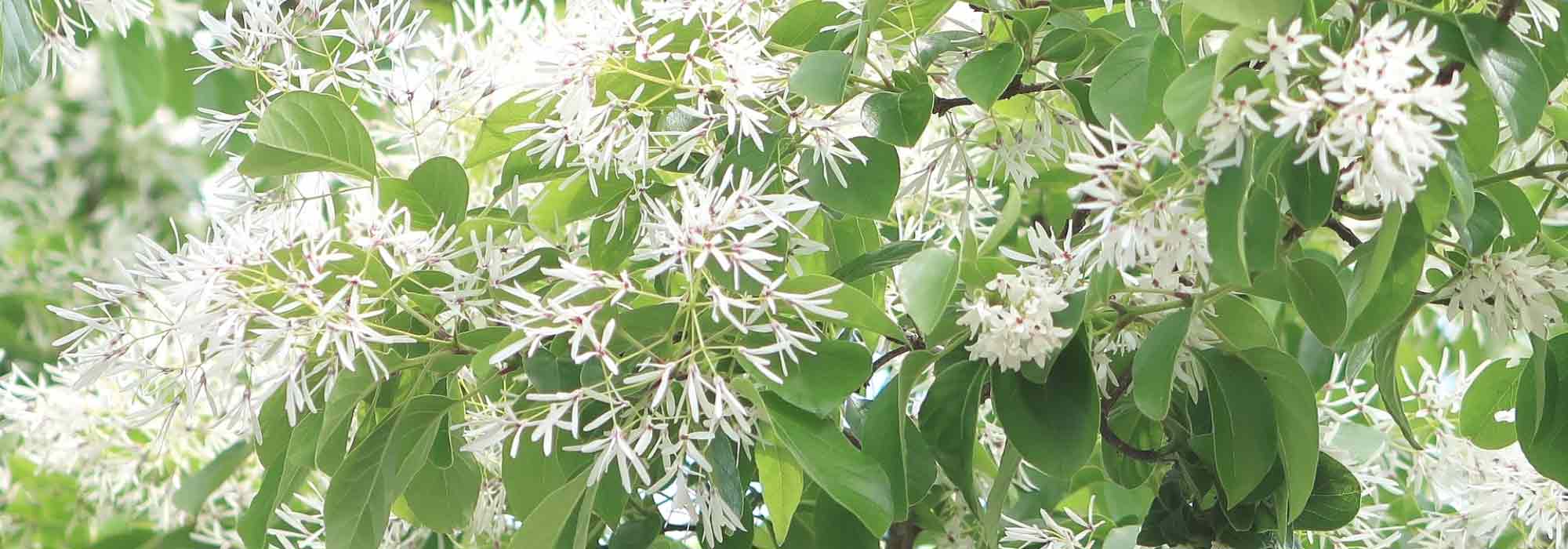
Chionanthus, snow tree: to plant, to grow
Contents
Chionanthus in a nutshell
- Chionanthus is a bush with wonderful white spring flowering, particularly abundant and airy
- It requires some patience, only beginning to flower after four years in cultivation
- Its bright green foliage in spring takes on a lovely golden colour in autumn
- Perfectly hardy and resistant to urban pollution, it thrives in full sun, in fairly acidic, humus-bearing and fresh soil
- It can be planted in a country-style flowering hedge, in borders of bushes on heather soil and even in a pot
A word from our expert
Still too little known, but much appreciated by collectors, Chionanthus, so prettily nicknamed “snow tree”, deserves to be more widely grown in our gardens for the delicate white, finely star-shaped flowering it displays in spring.
Whether in trailing panicles on Chionanthus virginicus or erect on Chionanthus retusus ‘Botanica’s beauty’ or “Chinese fringetree”, their very natural, tousled habit and slow growth suit naturalistic gardens, romantic gardens and city gardens alike.
Deciduous foliage on this bush is equally decorative; bright green at emergence, it takes on a lovely golden autumn colour.
Easy to grow, fully hardy, it thrives in sun, in rich, cool soils, preferably free of lime.
With a compact yet elegant habit, it finds its place easily in borders of heather soil bushes, or in a flowering country hedge.
Everything to know about this bush or small tree with its airy, immaculate flowering and tousled silhouette!
And what better way to emerge from winter than our spring-flowering bushes? Discover them!
Description and botany
Botanical data
- Latin name Chionanthus virginicus, Chionanthus retusus
- Family Oleaceae
- Common name Chionanthus
- Flowering May–June
- Height 2 to 10 m
- Exposure Sun, partial shade
- Soil type Acidic, well-drained
- Hardiness -20°C
Chionanthus, also nicknamed “snow tree” or “fringe tree”, is a bush in the family Oleaceae, like lilac, ash and olive. For a long time the genus comprised only two species of trees and bushes, the Chionanthus virginicus, the hardiest and most commonly seen in our gardens, and the Chionanthus retusus, native to woods, thickets and rocky hills of the southeastern United States for the former, and to Asia for the latter.
Slow-growing, it forms a small rounded bush, well branched from the base, with a spreading bushy habit, a little more umbrella-like in Chionanthus retusus. Reaching 5 to 10 metres in its natural habitat, it rarely exceeds, under our latitudes, 3 to 4 m in height for 5 m spread. Often forming several trunks but barely taller than wide, it is a valuable asset in small gardens.
Chionanthus virginicus and Chionanthus retusus have quite distinct appearances. In Chionanthus retusus the beautiful grey-ochre bark flakes or becomes deeply channelled with age.
Chionanthus has a remarkable, rather late flowering, which appears with the foliage and almost entirely covers it. Slow to appear, flowers only develop on plants aged 4 to 10 years. In May–June, an abundant white, feathery flowering covers the plant like a floccose cloud, giving the bush its common name “snow tree” or “snow flower”.
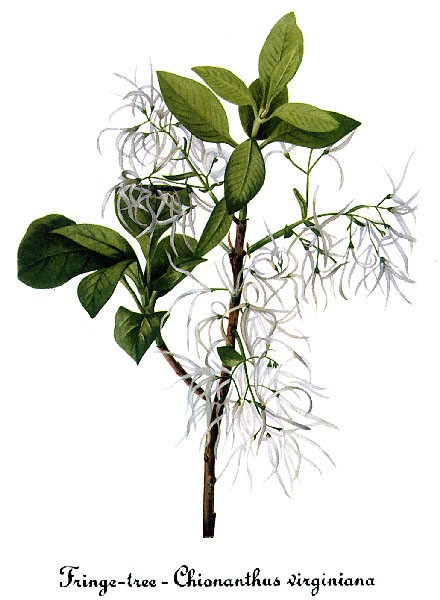
Chionanthus virginiana – botanical illustration by Mary Vaux Walcott
The very small, finely star-shaped flowers, 1 to 2 cm long, consist of four narrow linear white petals resembling ribbons or threads. Gathered in very dense panicles that can reach 20 cm long, they are upright in Chionanthus retusus, longer and pendulous and evocative of fringes in C. virginicus, even more attractive when seen from below!
They give off a slightly mentholated scent.
Chionanthus is dioecious, meaning there are male and female plants: fruiting only occurs if male and female specimens grow side by side. However, some Chionanthus are hermaphrodite and can fruit even without a nearby male, so fruiting remains very variable.
At the end of summer, on female plants the flowers are replaced by small waxy berries, oval drupes bluish-black or purplish-blue that are a favourite of birds.
The attractive, ample foliage composes a light, glossy backdrop, appearing from a distance as large umbels. In spring the shoots don a beautiful deciduous vegetation differing noticeably between species. Leaves are opposite, generally elliptical, measuring 4 to 12 cm in Chionanthus retusus versus 15 to 25 cm in C. virginicus. They are glossy above and have a white woolly underside in Chionanthus retusus. Ranging from bright to dark green, they turn golden yellow in autumn.
Hardy, Chionanthus does not fear cold (down to -25 °C for C. virginicus), and thrives throughout France, preferring warm summers and cold winters of continental climate.
It is a very easy-to-grow bush that flourishes in sun, in humus-bearing, cool, well-drained soils, with a preference for acidic, non-calcareous soils.
Its compact yet elegant silhouette and fairly slow growth make Chionanthus a bush that fits into all natural and naturalistic gardens and wild areas, even in small city gardens, forming attractive focal points. It can be grown alone as a specimen in centre of a heather soil bed or in groups combined with other spring-flowering bushes for meadow or flowering hedges.

Chionanthus retusus: bush silhouette in flower / flowering / fruiting / autumn foliage
In the past, Native Americans pounded the roots and bark to treat skin inflammations.
Read also
Pruning spring-flowering bushesMain species and varieties
Only two species of fringe tree are found in our gardens: the Chionanthus Retusus, an Asian arborescent species capable of reaching 20 m in height in its native habitat, more sensitive to severe cold, with decorative bark and upright panicles of flowers, and the American species Chionanthus Virginicus, hardier, whose flowering with pendulous panicles is spectacular.
Our favourites
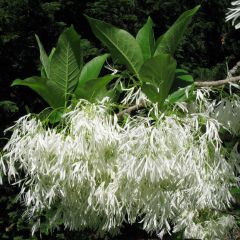
Chionanthus virginicus
- Flowering time May to July
- Height at maturity 3 m
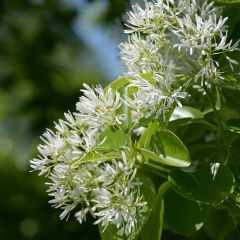
Chionanthus retusus
- Flowering time June, July
- Height at maturity 3 m
Discover other Chionanthus
View all →Available in 2 sizes
Available in 3 sizes
Planting
Where to plant Chionanthus or snow tree?
Capable of a good hardiness that varies by species (-25 °C for Chionanthus virginicus and -15 °C for C. retusus), Chionanthus can withstand negative temperatures if sheltered from cold, drying winds, which ensures excellent resistance in most regions.
It requires several years to settle before flowering well and only flourishes in sun, where it produces the most blooms. It will tolerate a shaded position in southern regions. Its foliage tolerates urban pollution well, making it a fine choice for city gardens.
It will adapt to any good deep, well-drained garden soil, but prefers a rich, non-calcareous, rather acidic soil that stays cool in summer. Chionanthus retusus, or “Chinese fringe tree”, tolerates lime in the soil even less than its American cousin. However, grafted onto an ash (Fraxinus ornus), this acidophilous plant can be grown on calcareous ground.
Very versatile, this very beautiful bush of rare grace can be used as a specimen to enrich a meadow-style bed with heather soil bushes or to form a pretty flowering, country-style hedge.
With its slow growth, it also suits small city gardens as well as cultivation in a large pot on a sunny terrace or balcony.
When to plant Chionanthus or fringe tree?
Planting Chionanthus can be done in spring from February to May or preferably in autumn from September to November, to favour rooting before winter.
How to plant Chionanthus?
In open ground
Chionanthus likes soils worked deeply with turf or potting compost. It is used in a mixed border, alone, in groups of three plants or in a free hedge at a density of 1 plant per m².
- Dig a hole 2 to 3 times wider than the pot
- Loosen the soil well
- Make a good bed of gravel at the bottom of the hole
- Mix half garden soil with turf, potting compost or well‑rotted compost
- Stake firmly
- Plant the bush at collar level
- Backfill while keeping the bush upright and firm the soil lightly at its base
- Firm soil at the base of the plant
- Mulch the base with a layer of leaf mould or compost to keep soil cool in summer
- Water generously during the first weeks to encourage establishment
+ tips for successful planting a bush on our sheet!
Growing fringe tree in a pot
The slow growth of Chionanthus allows cultivation in a large pot on a terrace, where it will release a delicate perfume in late spring.
- In a sufficiently large container, spread clay pellets or pumice
- Plant your bush in a mix of turf and good planting compost
- Water fairly regularly in summer as soon as soil is dry
Read also
Plant young ericaceous plantsMaintenance, pruning and care
Chionanthus is an easy-to-care-for bush and very hardy that suffers from neither pests nor diseases. In case of excess lime in soil, it can be prone to chlorosis, a condition causing discolouration and yellowing of leaves: add heather soil at planting.
In dry weather, monitor water needs, especially during first years. Preferably mulch base annually, in May, to maintain some moisture around base.
In spring, to stimulate growth and flowering of your Chionanthus you can apply an organic fertiliser.
Repot specimens in pots every two years into a larger container.
Pruning is not necessary, especially as flowering occurs only on old wood. A light annual prune is sufficient: remove dead or poorly placed wood towards end of winter, in February–March. You can also cut low branches if you wish to form a trunk.
Multiplication
Although Chionanthus or “snow tree” can be propagated by sowing or by grafting onto ash, we recommend layering, which is simpler to carry out.
By layering
Root development of layers is fairly slow, so be patient! Carry out at end of summer.
- Lower one of the low branches to the base of the tree
- Remove leaves and stems from this section
- Scrape bark over 5–10 cm with a small knife
- Dig a furrow in the soil nearby and bury part of the shoot to encourage rooting
- Backfill the furrow and secure the layer with two metal hooks
- Lift the tip and stake the above-ground part
- The following spring, or possibly the following autumn, separate the layer from the parent plant when it has sufficient roots
- Replant immediately in open ground
Combining snow tree with other garden plants
With its distinctive, gracefully tousled silhouette, Fringe tree brings in late spring a delightful touch of freshness to natural gardens, wild or English-style, in a large country border, mixed in a flowering hedge, as a striking punctuation in the middle of a short grass meadow or even in a romantic planter placed on the terrace.
It is an ideal bush for small gardens and city gardens.
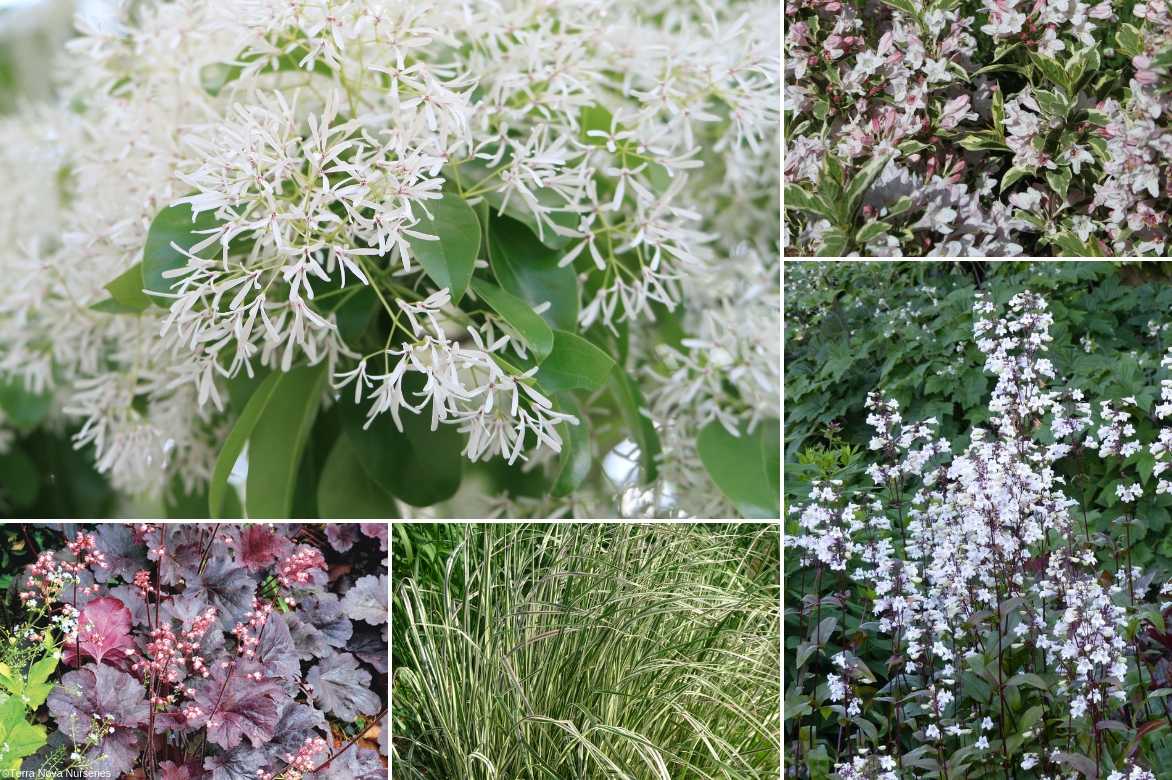
A planting idea: Chionanthus virginicus, Weigela Florida ‘Nana Variegata’, Penstemon digitalis ‘Husker Red’, Calamagrostis acutiflora ‘Overdam’ and Heuchera ‘Bella Notte’
It easily finds its place in a border of heather soil bushes such as Cornus, Camellias, deciduous Azaleas, Hydrangeas, Rhododendrons, Viburnums, Kalmias or Japanese Andromeda.
In spring, simply surround it with a tapetum of spring bulbs or perennials with spring flowering, such as white daffodils, alliums, lilies, Dutch irises, Eremurus, erythroniums or late tulips.
To fully enjoy its beauty, plant it against a permanent green backdrop composed of conifers and bushes with evergreen foliage that will showcase the delicate beauty of its flowers in spring and its golden-yellow foliage in autumn.
In a romantic garden, magnolias, white lilacs, serviceberries, buddleias and roses will accompany or take over from its flowering with their delicate hues.
In autumn, its foliage will blend beautifully with Cercidiphyllum japonicum (“Caramel tree”), Leucothoe, maples or deciduous spindle trees.
Useful resources
- There is no hedge more rewarding and easy to live with than a flowering hedge: our collection of suitable bushes is unique!
- Flowering hedge: which bushes to plant, when and how?
- Chionanthus fits well into a shrub border of heather soil bushes, discover them!
- Here are 5 tips to successfully grow heather soil bushes
- Subscribe!
- Contents
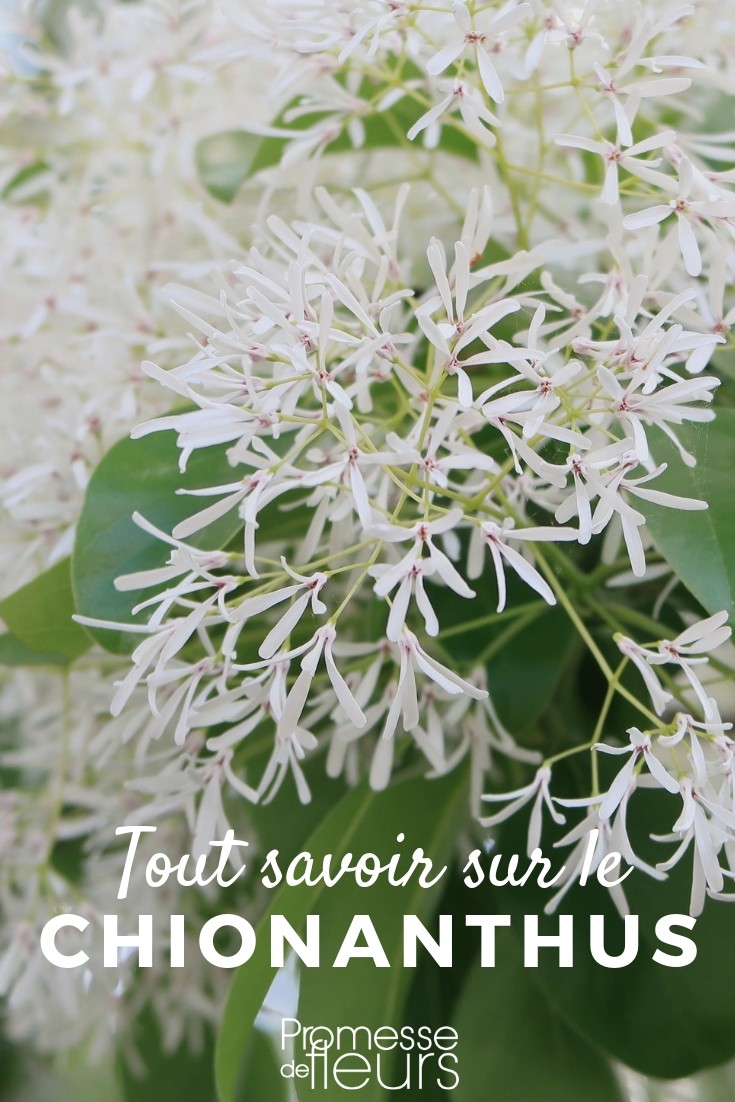

































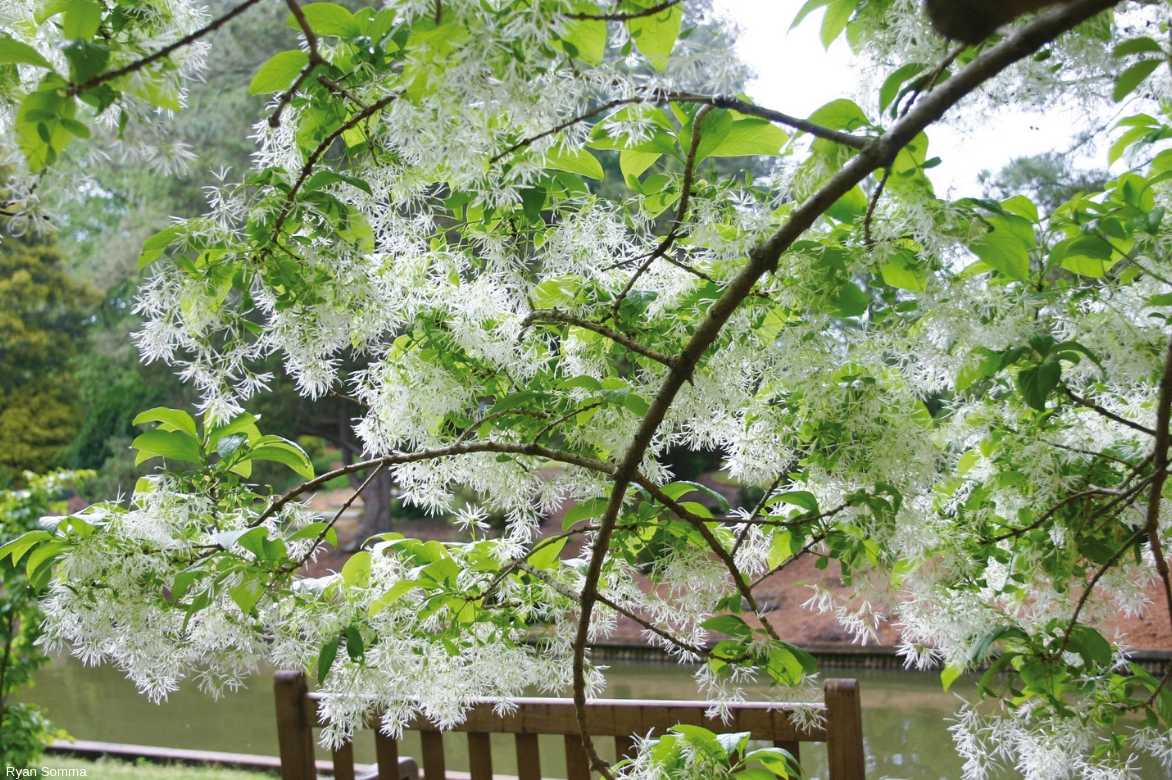
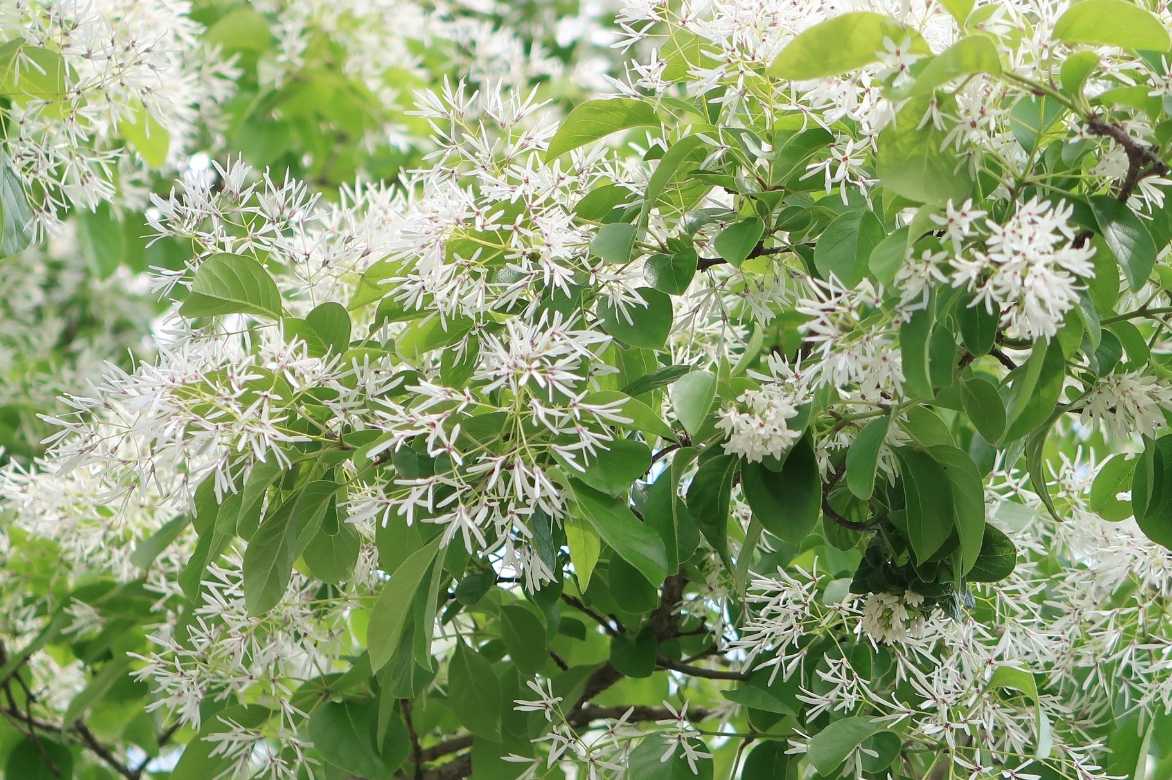
Comments